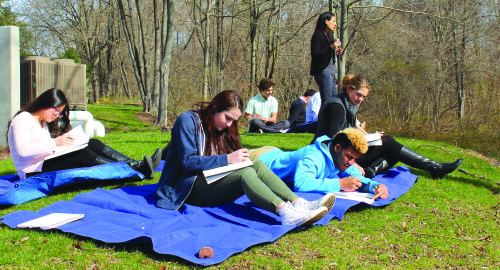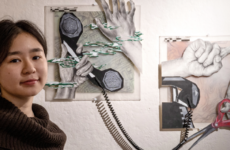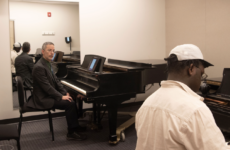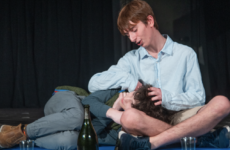This spring term, Choate inaugurated an environmental arts class proposed to combine artistic expression and environmental awareness in a single class. Ms. Jessica Cuni, who teaches the course, encouraged its creation to instill appreciation for the environment in a new generation of artists at Choate. “The course encompasses many different modes of art, including environmental and natural materials in the landscape and the creation of activist art to raise awareness about issues concerning the environment.”
Ms. Cuni’s involvement in the field outside of Choate has played a role in the creation of the course. She explained, “I was comissioned a site-specific artwork with the students in the class for a public environmental art festival in Middletown.” The goal of this project, titled “Quiet River,” is to “build a sound-attenuated chamber with a large picture window overlooking the Connecticut river,” to bring awareness to it. The chamber will honor the local landmark’s natural beauty without distraction from highways or artificial noises. This commission is a gateway for the course and has become an integral driving force for it.
Henry Jacob ’17 said, “Mrs. Cuni has turned her own idea into our major class project. We are currently working to design, build, and transport the structure before the festival begins on May 7.”
In addition to the large weight of their commissioned project, which they will work on throughout the month of April, the class also plans to work on nature journaling, Earth Day campaign posters, and temporary, site-specific pieces on campus.
On Thursday, April 14, the class embarked on a field trip to I-Park, an international environmental residency program environment. There, the students explored the artistic elements on site and enjoyed lunch with artists in the residence, from whom they learned much more about a spectrum of environmental artconcepts and processes.
Art is a powerful resource that inspires people around the world, and it is often married to advocacy. Ms. Kalya Yannatos, Director of the Arts, said, “It’s not enough to say ‘I’m an artist;’ use the gift of that opportunity to say, ‘I’m an artist who has something meaningful to say’.”
She went on, “It is important that we think holistically about the world that we inhabit. Nature is inspiring. If we’re paying attention and appreciating all that is before us, we should pay homage to the beauty that we see.”
Students are expected to work collaboratively and at the end of each week, they are expected to turn in reflections. Students also actively participate in seminar-based discussions of artistic concepts and ideas with their peers. This encourages further awareness of the environment and allows the them to reflect on the importance of their learning.
Students in the class have praised Ms. Cuni’s artistic talent and innovative teaching methods. But, most of all, they admire her passion and dedication, which never cease to positively influence her students. It not only enriches their knowledge of art, but also allows them to find a new appreciation for visual forms.
William Kanders ’19 said, “This class is special. I feel it’s going to push every student in it to be the best artist possible. It is the perfect fit.”





